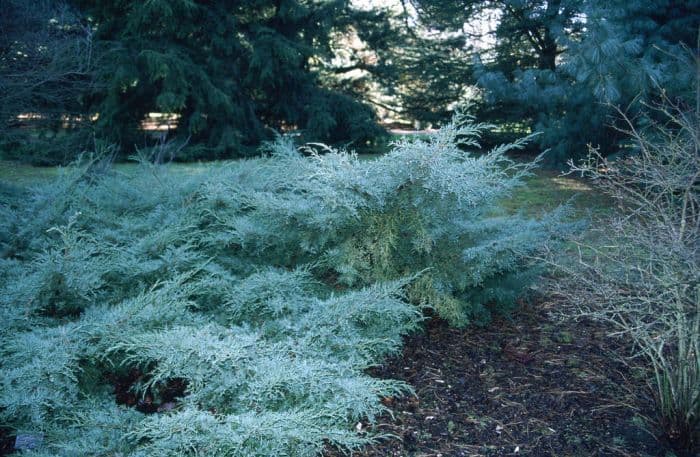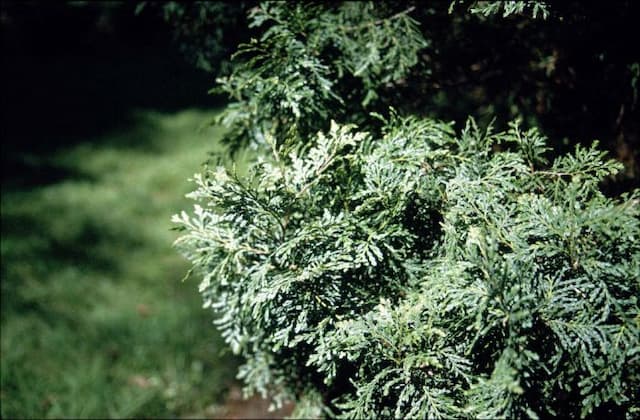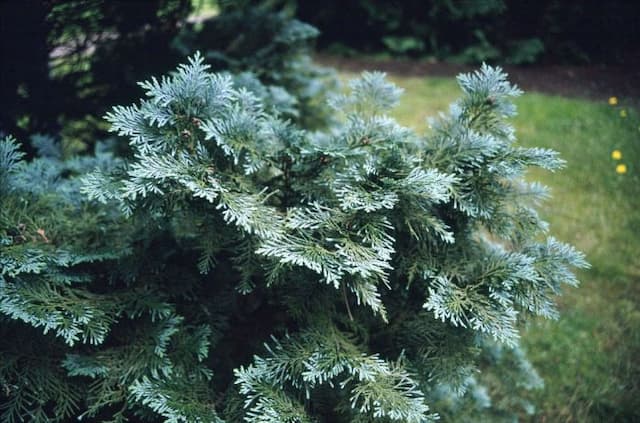Grey Owl Juniper Juniperus 'Grey Owl'

ABOUT
The Grey Owl Juniper is an evergreen shrub known for its striking appearance. It has graceful, spreading branches that create a lovely, broad shape. The foliage of this shrub is unique, with silvery-grey to bluish-green needle-like leaves that provide a soft, feathery texture. These needles often take on a slightly plum hue during cooler weather, adding to the plant's visual interest throughout the seasons. The Grey Owl Juniper produces small, clustered seed cones that can have a bluish or berry-like appearance, which may attract birds and other wildlife to the garden. The plant's overall form is dense and lush, making it an excellent choice for adding a touch of elegance to landscaping. Its distinctive silver-grey foliage color stands out against green lawns and complements other plants in garden beds.
About this plant
 Names
NamesFamily
Cupressaceae
Synonyms
Grey Owl Juniper
Common names
Juniperus 'Grey Owl'.
 Toxicity
ToxicityTo humans
Grey Owl Juniper is considered to have a low level of toxicity for humans. However, ingesting parts of the plant, especially in large quantities, may cause gastrointestinal upset, including symptoms like nausea, vomiting, and diarrhea. It is generally advised to avoid consumption of this plant to prevent any potential negative effects.
To pets
Grey Owl Juniper is also considered to have a low level of toxicity for pets. If pets consume parts of the plant, they might experience mild gastrointestinal discomfort, which could manifest as vomiting or diarrhea. It's recommended to keep an eye on your pet and consult a veterinarian if you notice any adverse symptoms after ingestion.
 Characteristics
CharacteristicsLife cycle
Perennials
Foliage type
Evergreen
Color of leaves
Blue-green
Height
3 feet (0.91 meters)
Spread
6 feet (1.83 meters)
Plant type
Shrub
Hardiness zones
3
Native area
North America
Benefits
 General Benefits
General Benefits- Low Maintenance: The Grey Owl Juniper requires minimal care once established, making it an ideal choice for gardeners seeking low-maintenance landscaping options.
- Drought Tolerance: It is highly resistant to drought, allowing it to thrive in arid conditions where other plants might struggle.
- Erosion Control: The plant's dense growth habit helps to prevent soil erosion, particularly on slopes and in areas prone to heavy rains.
- Attracts Wildlife: Birds are attracted to the Grey Owl Juniper for shelter, while its berries can provide a food source for various bird species.
- Year-Round Interest: With its silvery-blue foliage, the plant offers visual interest throughout the year, even in winter when other plants have lost their leaves.
- Ground Cover: Its spreading habit makes it an excellent choice for covering large areas, reducing the need for mulch and suppressing weed growth.
- Deer Resistance: The Grey Owl Juniper is not a preferred food source for deer, which can help protect it from grazing damage in areas with deer populations.
 Medical Properties
Medical PropertiesThis plant is not used for medical purposes.
 Air-purifying Qualities
Air-purifying QualitiesThis plant is not specifically known for air purifying qualities.
 Other Uses
Other Uses- Photography Backdrops: 'Grey Owl' juniper, with its silvery-blue foliage, provides a unique and appealing texture that is excellent for photographers, especially for portrait backdrops or macro photography.
- Theme Gardens: This plant is often used in themed garden designs, such as fantasy or medieval gardens, due to its old-world charm and distinctive appearance.
- Bonsai Specimen: 'Grey Owl' juniper can be cultivated as a bonsai plant, offering a challenge to bonsai enthusiasts looking to shape and maintain its unique foliage in miniature form.
- Culinary Garnish: Although not commonly known for culinary uses, the branches and berries of 'Grey Owl' juniper can be used as a garnish for plating dishes, provided the specific variety is verified to be non-toxic.
- Artistic Impressions: Artists and sculptors may use dried or cast forms of 'Grey Owl' juniper branches and foliage as inspiration or elements in their works due to their visual appeal.
- Film and Theatre: 'Grey Owl' juniper is utilized in set design for movies and theatre productions to mimic an evergreen ambiance or to create intricate forests and landscape settings.
- Aromatic Sachets: Dried foliage and berries can be included in sachets to impart a woodsy scent to closets and drawers, though the scent is usually mild and not as potent as other junipers.
- Wildlife Shelter: On a functional level, this juniper variety offers shelter and nesting sites for birds and other small wildlife within a garden or landscape setting.
- Ice Melt Barrier: Planted in rows, 'Grey Owl' juniper can act as a barrier to prevent ice melt chemicals from reaching more sensitive areas of the landscape.
- Erosion Control: Its dense growth pattern and root system can be effective in stabilizing soil on slopes, thus helping in the prevention of erosion.
Interesting Facts
 Feng Shui
Feng ShuiThe Grey Owl Juniper is not used in Feng Shui practice.
 Zodiac Sign Compitability
Zodiac Sign CompitabilityThe Grey Owl Juniper is not used in astrology practice.
 Plant Symbolism
Plant Symbolism- Protection – Juniperus 'Grey Owl', commonly known as Grey Owl Juniper, is often associated with protection due to its durable and evergreen nature, suggesting an ability to safeguard and endure all seasons.
- Purity – Grey Owl Juniper is believed to symbolize purity, as its leaves and berries have been used historically in various cultures for purification rituals and cleansing ceremonies.
- Healing – With its purported antiseptic properties, the plant is often related to healing and medicine, symbolizing health and recovery.
- Longevity – The long-lived nature of the juniper plant stands for longevity and eternal life, embodying the idea of living through time and enduring challenges.
 Water
WaterGrey Owl Junipers should be watered moderately, with the soil allowed to dry out slightly between waterings to avoid over-saturation and root rot. During the initial establishment period after planting, generally the first year, water them deeply once a week with about 1 to 2 gallons per plant, depending on the size and environmental conditions. After establishment, they require less frequent watering, and you can reduce to biweekly or even monthly deep watering, especially in areas with natural rainfall. In hot and dry climates, increase the frequency of watering, and during winter months, water them only if the ground is not frozen and they appear to need moisture.
 Light
LightGrey Owl Junipers thrive in locations where they can receive full sun for most of the day. These plants prefer at least six hours of direct sunlight daily. The best spot for a Grey Owl Juniper is an open area without shade from buildings or taller plants where they can bask in unobstructed sunlight.
 Temperature
TemperatureThe Grey Owl Juniper is cold-hardy and can tolerate temperatures down to about -20°F, making it suitable for many temperate regions. They can survive high temperatures well above 100°F, but may require additional watering in extreme heat. Ideally, they thrive in temperatures ranging from 70°F to 90°F, maintaining good health and growth.
 Pruning
PruningPruning Grey Owl Junipers is necessary to maintain their attractive shape and dense foliage. They should be pruned in late winter or early spring before new growth starts. Light pruning annually or biennially is sufficient to remove any dead or damaged branches and encourage a tidy growth habit. The best time for more extensive shaping is also during this dormant period.
 Cleaning
CleaningAs needed
 Soil
SoilGrey Owl Juniper thrives in well-drained soil with a pH of 6.0 to 8.0. A suitable soil mix for this conifer could be equal parts of gardening soil, peat moss, and sharp sand to ensure proper drainage. Regular garden soil can also be amended with organic compost to improve fertility and structure.
 Repotting
RepottingGrey Owl Junipers don't need frequent repotting, and typically, they are repotted once every 3 to 4 years. Younger plants may require more frequent repotting, while mature specimens can go longer without being disturbed.
 Humidity & Misting
Humidity & MistingGrey Owl Juniper is adapted to outdoor conditions and generally prefers low to moderate humidity levels common in its natural outdoor environment. It does not require specific humidity adjustments when planted in proper outdoor settings.
 Suitable locations
Suitable locationsIndoor
Provide bright light, occasional watering, and good air circulation.
Outdoor
Plant in full sun, well-draining soil, and water as needed.
Hardiness zone
3-9 USDA
 Life cycle
Life cycle'Grey Owl' Juniper, a cultivar of Juniperus virginiana, begins its life cycle as a seed, which after stratification germinates in spring under suitable conditions. The seedling stage involves growth of the primary root and the emergence of cotyledons, followed by the development of scale-like leaves characteristic of mature juniper foliage. As it enters the juvenile phase, the plant focuses on vegetative growth, rapidly increasing in size and producing sturdy stems that begin to exhibit its distinctive spreading and somewhat arching habit. Transitioning to the adult phase, 'Grey Owl' Juniper will start producing cones, with separate male and female cones often on different plants given its dioecious nature; females produce berry-like structures that are actually cones with fleshy and merged scales. These cones mature and, once pollinated by wind-borne pollen from male cones, will produce seeds to complete the life cycle. Throughout its life, which can span several years, 'Grey Owl' Juniper is relatively low maintenance, requiring only occasional pruning to maintain shape and health.
 Propogation
PropogationPropogation time
Late Winter to Early Spring
The Grey Owl Juniper is commonly propagated through semi-hardwood cuttings, typically done in late summer. To propagate using this method, one should select healthy stems that are not too green or too woody, and cut a length of 4 to 6 inches (10 to 15 cm). The cuttings should then have the bottom foliage removed to expose a clean stem. Dipping the cut end into a rooting hormone can promote better root development. The prepared cuttings are then inserted into a well-draining growing medium, like a mix of peat and perlite or sand, and should be kept in a humid environment to prevent drying out until roots develop. It generally takes several weeks to a few months for the cuttings to root sufficiently, after which they can be planted in a more permanent location.









